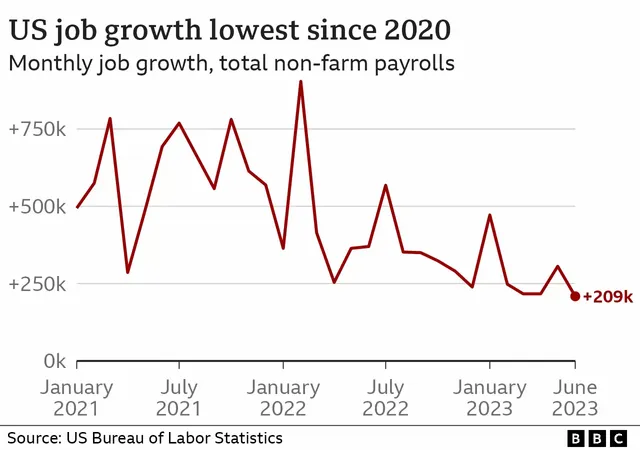
US Jobs Growth Weakest in More Than Two Years
The US economy added just 209,000 jobs in June, the smallest gain in more than two years, according to the Labor Department. The unemployment rate remained unchanged at 3.6%, but economists had expected job growth to be much stronger, at around 270,000.
The slowdown in job growth is a sign that the Federal Reserve's aggressive interest rate hikes are starting to take a toll on the economy. The Fed has raised rates by 1.5 percentage points since March in an effort to cool inflation, which is at a 40-year high.
Higher interest rates make it more expensive for businesses to borrow money, which can lead to slower investment and hiring. The Fed is expected to continue raising rates in the coming months, which could further dampen economic growth.
Despite the slowdown in job growth, the labor market remains strong overall. The unemployment rate is near a record low, and wages are rising at a healthy pace. However, the report did show some signs of weakness, such as a decline in the number of job openings.
The slowdown in job growth is likely to be a welcome relief to some businesses, which have been struggling to find workers in recent months. However, it could also lead to slower economic growth and higher unemployment in the future.
What are the implications of the weak job growth?
The weak job growth in June has a number of implications for the US economy. First, it suggests that the Fed's interest rate hikes are starting to have an impact on economic activity. Second, it could lead to slower wage growth in the coming months. Third, it could increase the risk of a recession.
The Fed has said that it is willing to accept some slowdown in economic growth in order to bring inflation under control. However, if the job market continues to weaken, the Fed may have to reconsider its tightening plans.
What can businesses do to prepare for the weak job growth?
Businesses that are expecting slower job growth in the coming months should start planning now. This could include:
Rethinking their hiring strategies. For example, they may need to focus on hiring more experienced workers or workers with in-demand skills.
Investing in automation and other technologies that can help them to do more with fewer workers.
Developing a more flexible workforce that can adapt to changing economic conditions.
By taking these steps, businesses can help to mitigate the impact of the weak job growth and stay competitive in the long run.
What can the government do to help the economy?
The government can play a role in helping the economy by:
Continuing to support businesses through tax breaks and other incentives.
Investing in infrastructure and other projects that can create jobs.
Making it easier for businesses to hire workers by streamlining regulations.
By taking these steps, the government can help to boost economic growth and create more jobs.
Conclusion
The weak job growth in June is a sign that the US economy is starting to slow down. This is likely due to the Fed's interest rate hikes, which are making it more expensive for businesses to borrow money. The slowdown in job growth could lead to slower wage growth and an increased risk of a recession. Businesses should start planning now to mitigate the impact of the weak job growth. The government can also play a role in helping the economy by continuing to support businesses and investing in infrastructure.